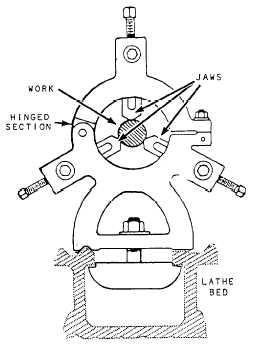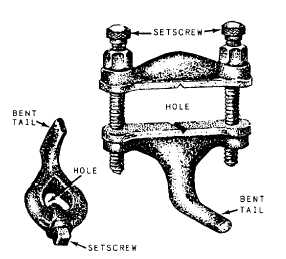Figure 9-11.—60-degree lathe centers.
Figure 9-12.—Lathe dogs.
Lathe Centers
The 60-degree lathe centers shown in figure 9-11
provide a way to hold the work so it can be turned
accurately on its axis. The headstock spindle center is
called the LIVE CENTER because it revolves with the
work. The tailstock center is called the DEAD
CENTER because it does not turn. Both live and dead
centers have shanks turned to a Morse taper to fit the
tapered holes in the spindles; both have points finished
to an angle of 60°. They differ only in that the dead
center is hardened and tempered to resist the wearing
effect of the work revolving on it. The live center
revolves with the work and is usually left soft. The dead
center and live center must NEVER be interchanged.
(There is a groove around the hardened dead center to
distinguish it from the live center.)
The centers fit snugly in the tapered holes of the
headstock and tailstock spindles. If chips, dirt, or burrs
prevent a perfect fit in the spindles, the centers will not
run true.
To remove the headstock center, insert a brass rod
through the spindle hole and tap the center to jar it loose;
then pull it out with your hand. To remove the tailstock
center, run the spindle back as far as it will go by turning
the handwheel to the left. When the end of the tailstock
Figure 9-13.—Center rest.
screw bumps the back of the center, it will force the
center out of the tapered hole.
Lathe Dogs
Lathe dogs are used with a driving plate or faceplate
to drive work being machined on centers; the frictional
contact alone between the live center and the work is not
sufficient to drive the work
The common lathe dog, shown at the left in figure
9-12, is used for round work or work having a regular
section (square, hexagon, octagon). The piece to be
turned is held firmly in the hole (A) by the setscrew (B).
The bent tail (C) projects through a slot or hole in the
driving plate or faceplate so that when the tail revolves
with the spindle it turns the work with it. The clamp dog,
illustrated at the right in figure 9-12, may be used for
rectangular or irregularly shaped work. Such work is
clamped between the jaws,
Center Rest
The center rest, also called the steady rest, is used
for the following purposes:
1. To provide an intermediate support for long
slender bars or shafts being machined between centers.
The center rest prevents them from springing, or
sagging, as a result of their otherwise unsupported
weight.
9-8







